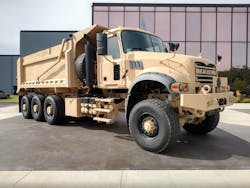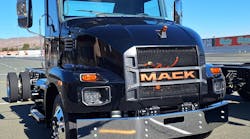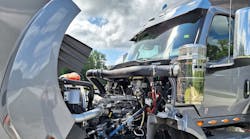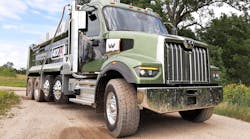Mack Defense has delivered the first five of a new group of heavy dump trucks to the U.S. Army for acceptance testing, and more than 1,200 could follow if planned funding materializes, officials said during a turnover ceremony last Friday at Mack Trucks’ customer center in Allentown, Pa. The initial $296 million contract is for 683 trucks plus development costs.
The M917A3 trucks are militarized versions of Mack’s Granite commercial vocational model, with Mack picking components based on the Army’s performance needs.
“Instead of us telling the industry, ‘This is what we want,’ we gave them our operating requirements and let them tell us what they’d build,” said Lt. Col. Jefferey Jurand, program manager for the Army’s heavy tactical vehicles. “We asked them to only modify an existing commercial vehicle, leveraging their internal investments and economies of scale.”
Unit cost for an M917A3 heavy dump will be about $380,000 when the program is well along, he said. The goal for full-rate production is October 2020, and it could run into 2025 with follow-on orders, said Dave Hartzell, president/CEO of Mack Defense, a Mack Trucks subsidiary.
The new trucks will replace original M917 series trucks built by AM General, some of which are 50 years old, Jurand said. About half of the new trucks will go to Army Reserve and National Guard units and the rest to active Army combat support units, and for pre-positioning in overseas depots; all are subject to being deployed overseas. He said he is trying to interest Navy officials in acquiring some of the new trucks for use by Seabee construction units.
Mack will build the trucks in its plant at Macungie, Pa., with armored cabs coming from JWF Defense in Johnstown, Pa. Standard and armored cabs can be switched in the field if necessary, Mack officials said.
Aside from the Granite cab and chassis, civilian-type components include a Mack MP8 diesel, Allison 6-speed automatic transmission, Fabco 2-speed transfer case, and Meritor front- and rear-driving axles in an all-wheel-drive 8x8 configuration. Other published specs are a wheelbase of 243 inches and a platform length of 230 inches.
Frame rails are 11.8 inches high and have full-length inserts. Gross vehicle weight rating is 94,500 pounds for an on-road payload of 27 tons. Crysteel is supplying the 14-cubic-yard bodies fashioned of AR 450 high-strength steel.
The 12.8-liter MP8 diesel is rated at 440 horsepower and 1,650 lb.-ft., and meets Euro 3 emissions standards. Because the Army uses high-sulfur JP4 fuel, there is no exhaust aftertreatment equipment like civilian diesels must have. A split electrical system includes 24-volt engine cranking and 12 volts for lighting, instruments, and body controls. There are six military-spec batteries, and LED lights include Truck-Lite headlamps.
Army engineer units will use the trucks for road and bridge construction and paving, Jurand said. The 17-foot-long by 102.3-inch-wide body is designed to carry dirt, sand, gravel, demolition rubble, and hot asphalt, among other things. Its tail gate has four driver-controlled chutes for precise furrow placement of aggregates. The truck is air transportable by C-17 cargo planes, and includes extra-heavy-duty hardware for tie-down, towing, and lifting.
Young soldiers will find the trucks easy to drive because of their Allison automatic transmissions, which the Army has standardized on for many years, and the tri-drive rear axles in lieu of a tandem-and-lift-axle arrangement, said John Micelli, Mack Defense’s manager for government relations and pubic affairs. Three rear driving axles also provide superior traction on and off road.
The M917A3 is the third generation of the Army’s civilian-based heavy dumpers; A1 and A2 models were built by Freightliner, which did not bid on this contract. Mack beat out Navistar Defense for the order, Jurand said. Assuming the trucks pass their acceptance testing, 14 more will be bought during the next fiscal year and full production is slated for October 2020.





